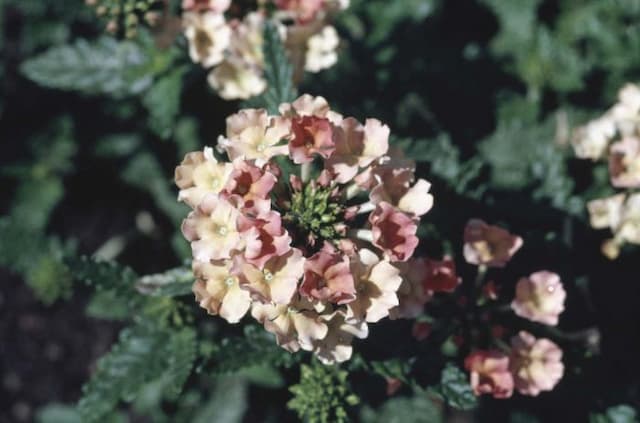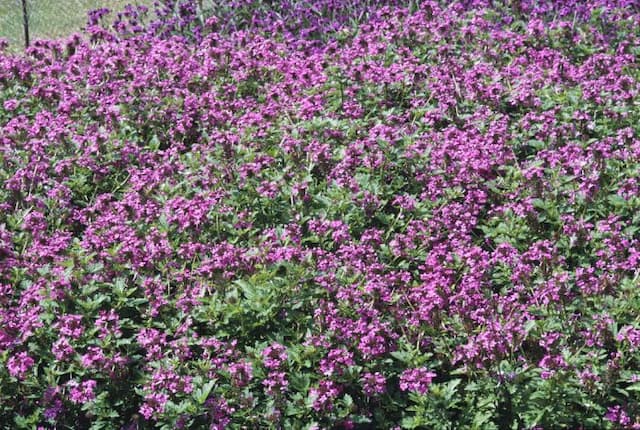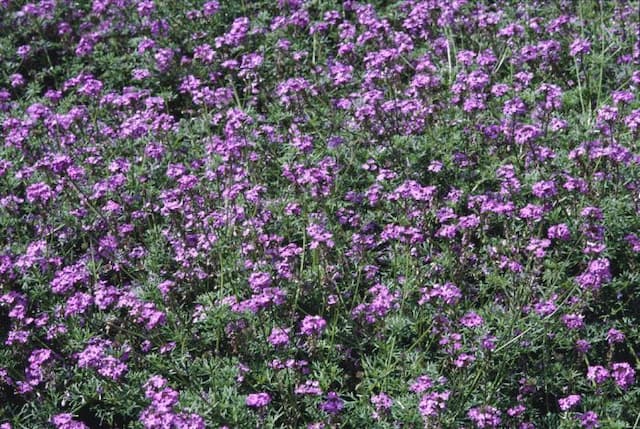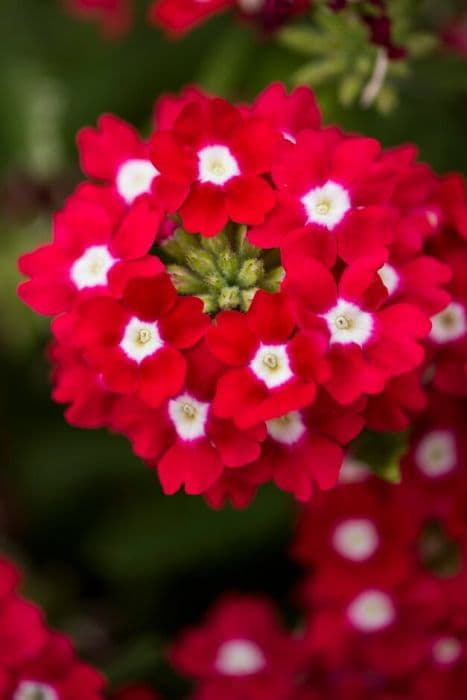Homestead Purple Verbena Glandularia 'Homestead Purple'

ABOUT
Homestead Purple is a vibrant and spreading plant known for its lush foliage and profusion of flowers. The leaves are deep green, with a slightly quilted texture, and they grow on stems that sprawly freely across the ground. This growth habit gives the plant a dense and full appearance, creating a mat-like coverage wherever it is planted. The most striking feature of Homestead Purple is its flowers. They are small, trumpet-shaped blossoms that cluster together to form eye-catching, vibrant purple flower heads. These flowers are particularly known for their long blooming period, covering the plant in a sea of purple throughout the growing season. The overall aesthetic of Homestead Purple is one of a robust, flowering groundcover with a bold color and dynamic presence in any garden setting.
About this plant
 Names
NamesFamily
Verbenaceae.
Synonyms
Homestead Purple Verbena, Homestead Purple Vervain.
Common names
Verbena canadensis 'Homestead Purple', Verbena 'Homestead Purple'.
 Toxicity
ToxicityTo humans
The Homestead Purple verbena is not known to be toxic to humans. No significant toxicity has been reported from ingesting this plant.
To pets
The Homestead Purple verbena is also not considered toxic to pets. It does not typically cause symptoms of poisoning in animals if ingested. However, as with any non-food plant, consuming large quantities may lead to gastrointestinal upset or discomfort.
 Characteristics
CharacteristicsLife cycle
Perennials
Foliage type
Deciduous
Color of leaves
Green
Flower color
Purple
Height
1-2 feet (0.3-0.6 meters)
Spread
2-3 feet (0.6-0.9 meters)
Plant type
Herb
Hardiness zones
7
Native area
Americas
Benefits
 General Benefits
General Benefits- Long Blooming Period: Homestead Purple verbena has a lengthy flowering season, typically from spring to fall, providing extended color in the garden.
- Drought Tolerance: Once established, it is highly drought-resistant, making it an excellent choice for xeriscaping or low-water-use gardens.
- Heat Resistance: This plant thrives in hot climates, making it ideal for warm regions where other plants might struggle.
- Attracts Pollinators: The vibrant flowers attract butterflies, bees, and other pollinators, supporting biodiversity in the garden.
- Ground Cover: It spreads out to form a dense mat, which can help prevent soil erosion and suppress weeds.
- Low Maintenance: Homestead Purple verbena requires minimal care once established, making it an easy plant for beginner gardeners.
- Colorful Landscape Addition: Its purple flowers add a striking burst of color to borders, beds, and containers.
- Deer Resistance: The plant is not a favorite of deer, so it typically does well in areas where deer browsing can be a problem for gardens.
 Medical Properties
Medical Properties- This plant is not used for medical purposes.
 Air-purifying Qualities
Air-purifying QualitiesThis plant is not specifically known for air purifying qualities.
 Other Uses
Other Uses- Artistic Dye: 'Homestead Purple' flowers can be used to create a natural dye for fabrics, providing a unique and eco-friendly option for textile coloring.
- Insectary Plant: It can serve as a host for beneficial insects, attracting them to the garden and helping with natural pest control.
- Homestead Purple' can be used in themed gardens to create a visually striking 'purple patch' that can serve as a focal point due to its vibrant purple blooms.
- Educational Tool: This plant can be used in schools or educational programs to teach about plant growth, pollination, and the needs of perennial plants.
- Photography Subject: With its stunning blooms, 'Homestead Purple' makes a popular subject for photographers, both amateur and professional, interested in capturing the beauty of plants.
- Culinary Garnish: Although not typically used for consumption, the bright flowers can be utilized as an edible garnish to add color to salads and desserts.
- Livestock Forage: In areas where it is not considered toxic, 'Homestead Purple' may be grazed upon by livestock, though this is not a common practice.
- Mood Enhancer: The vibrant color and pleasant appearance of the plant can have a positive effect on mental well-being when placed in living or working spaces.
- Creative Crafting: The stems and flowers can be incorporated into craft projects, such as wreaths or dried flower arrangements.
- Soil Erosion Control: When planted in masses, 'Homestead Purple' can help to stabilize soil and prevent erosion on slopes or banks.
Interesting Facts
 Feng Shui
Feng ShuiThe Homestead Purple Verbena is not used in Feng Shui practice.
 Zodiac Sign Compitability
Zodiac Sign CompitabilityThe Homestead Purple Verbena is not used in astrology practice.
 Plant Symbolism
Plant Symbolism- Perseverance: Homestead Purple, or Purple Verbena, blooms fiercely and can spread vigorously, often symbolizing the ability to thrive and persist in challenging environments.
- Healing: Known for its medicinal properties, the herb aspect of the Verbena suggests a connection to healing and the restoration of health.
- Harmony: Often used in gardens to bring together diverse plantings, Purple Verbena can represent the idea of harmony and unity amidst variety.
- Protection: Historically, Verbena has been associated with spiritual protection and was used in rituals to ward off evil spirits, thereby symbolizing safeguarding.
 Water
WaterHomestead Purple verbena should be watered deeply once a week, allowing the soil to dry out between waterings. Provide approximately one inch of water (about 0.6 gallons for a small plant) each time to ensure the root zone is thoroughly moistened. During periods of high heat or drought, watering frequency may need to increase to twice a week. Overwatering or allowing the plant to sit in soggy soil can lead to root rot, so ensure proper drainage.
 Light
LightHomestead Purple verbena thrives best in full sun, where it can receive at least six to eight hours of direct sunlight daily. This lighting condition promotes the most vigorous growth and abundant flowering. If planted indoors, place it near a south-facing window to ensure it gets enough light. Adequate sunlight is crucial for keeping Homestead Purple verbena healthy and blooming.
 Temperature
TemperatureHomestead Purple verbena performs best in temperatures between 60°F and 90°F. It can withstand short periods of colder weather but should be protected from frost, as it can only survive minimum temperatures down to about 20°F. During the active growing season, maintaining a temperature range within the ideal limits will promote lush growth and flowering.
 Pruning
PruningPruning Homestead Purple verbena encourages bushier growth and more blooms. Trim back the tips of the stems in early spring to stimulate branching, and deadhead spent flowers regularly to promote continuous blooming throughout the season. A more substantial cutback can be done in the late summer or early fall to rejuvenate plants that have become leggy or overgrown.
 Cleaning
CleaningAs needed
 Soil
SoilHomestead Purple Verbena thrives in a well-draining soil mix with compost and perlite. It prefers a slightly acidic to neutral pH, ranging from 6.0 to 7.0.
 Repotting
RepottingHomestead Purple Verbena should be repotted every 2-3 years to refresh the soil and accommodate root growth.
 Humidity & Misting
Humidity & MistingHomestead Purple Verbena is adaptable but does best in moderate humidity conditions; avoid overly humid environments.
 Suitable locations
Suitable locationsIndoor
Provide bright light and good air circulation for Homestead Purple Verbena.
Outdoor
Plant in full sun and well-draining soil for best Homestead Purple growth.
Hardiness zone
7-10 USDA
 Life cycle
Life cycleGlandularia 'Homestead Purple', commonly known as Homestead Purple Verbena, begins its life as a seed that germinates in warm soil with adequate moisture. Once sprouted, the seedling develops into a vegetative stage with characteristic bright green, textured foliage and begins to form a low, spreading mound. As it matures, the Homestead Purple Verbena enters the flowering stage, producing vibrant purple flowers prolifically throughout the warm months, often from spring until frost. Throughout its life, this perennial performs a semi-woody growth pattern that may die back in colder climates, entering a dormancy phase during the winter. With the onset of warmer temperatures and longer days, the plant revives from the root system, initiating a new cycle of growth and blooming. To complete its life cycle, the Homestead Purple Verbena will produce seeds that can be dispersed to give rise to new plants, ensuring the continuation of its species.
 Propogation
PropogationPropogation time
Spring-Early Summer
For the Homestead Purple verbena (Glandularia 'Homestead Purple'), the most popular method of propagation is through cuttings. This is commonly done in late spring or early summer when the plant is actively growing. A gardener would take a 3 to 4-inch cutting (about 7.5 to 10 cm) from a healthy stem that doesn’t have flowers. It's crucial to make a clean cut just below a node and to remove the lower leaves. The cut end of the stem is then dipped in rooting hormone to encourage root development and is planted in a mixture of moistened potting soil and perlite or sand to provide good drainage. The cutting should be kept in warm, indirect light and should not be allowed to dry out, with roots typically forming in a few weeks. Once the new plant has established a healthy root system, it can be transplanted to its desired location.




![Vervain [Donalena Lavender Grace]](/_next/image?url=https%3A%2F%2Fplants-admin.emdemapps.com%2Fimages%2Fplants%2F%2Fimages%2F604b575c837e7.png&w=640&q=75)

![Vervain [Endurascape Pink Bicolor]](/_next/image?url=https%3A%2F%2Fplants-admin.emdemapps.com%2Fimages%2Fplants%2F%2Fimages%2F604b594e749b0.png&w=640&q=75)

![Vervain [Seabrook's Lavender]](/_next/image?url=https%3A%2F%2Fplants-admin.emdemapps.com%2Fimages%2Fplants%2F%2Fimages%2F604b650ea9729.png&w=640&q=75)